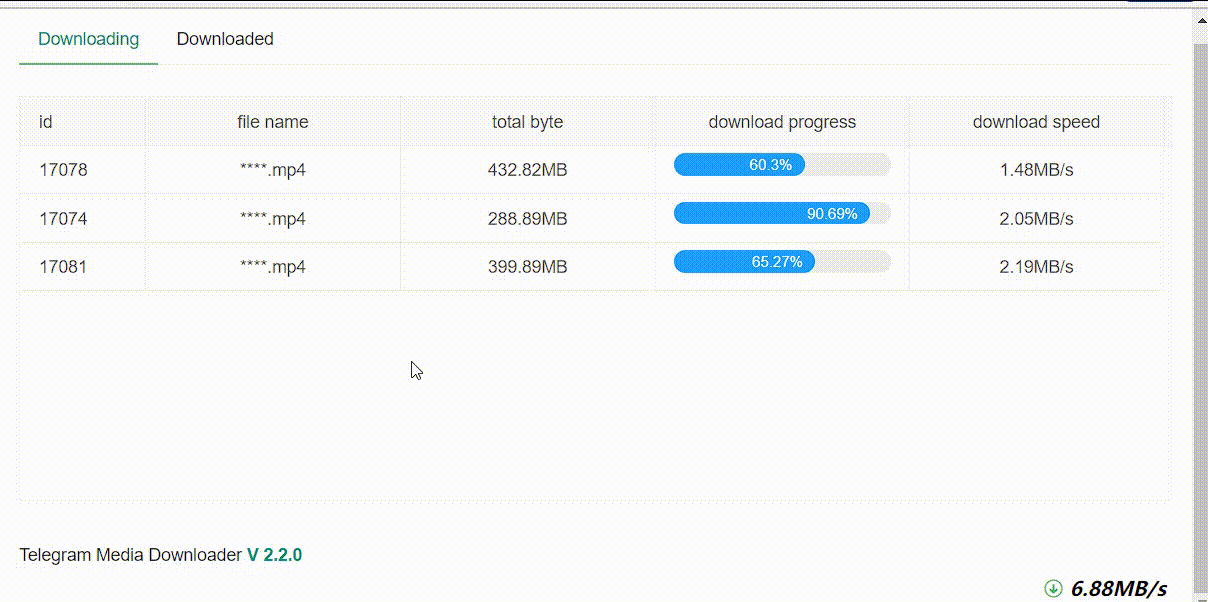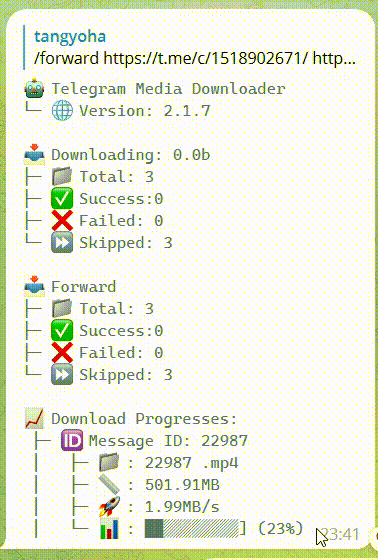中文 · Feature request · Report a bug · Support: Discussions & Telegram Community
Support two default running
-
The robot is running, and the command
downloadorforwardis issued from the robot -
Download as a one-time download tool
After running, open a browser and visit
localhost:5000If it is a remote machine, you need to configure web_host: 0.0.0.0
Need to configure bot_token, please refer to Documentation
| Category | Support |
|---|---|
| Language | Python 3.7 and above |
| Download media types | audio, document, photo, video, video_note, voice |
For *nix os distributions with make availability
git clone https://github.com/tangyoha/telegram_media_downloader.git
cd telegram_media_downloader
make installFor Windows which doesn't have make inbuilt
git clone https://github.com/tangyoha/telegram_media_downloader.git
cd telegram_media_downloader
pip3 install -r requirements.txtFor more detailed installation tutorial, please check the wiki
Make sure you have docker and docker-compose installed
docker pull tangyoha/telegram_media_downloader:latest
mkdir -p ~/app && mkdir -p ~/app/log/ && cd ~/app
wget https://raw.githubusercontent.com/tangyoha/telegram_media_downloader/master/docker-compose.yaml -O docker-compose.yaml
wget https://raw.githubusercontent.com/tangyoha/telegram_media_downloader/master/config.yaml -O config.yaml
wget https://raw.githubusercontent.com/tangyoha/telegram_media_downloader/master/data.yaml -O data.yaml
# vi config.yaml and docker-compose.yaml
vi config.yaml
# The first time you need to start the foreground
# enter your phone number and code, then exit(ctrl + c)
docker-compose run --rm telegram_media_downloader
# After performing the above operations, all subsequent startups will start in the background
docker-compose up -d
# Upgrade
docker pull tangyoha/telegram_media_downloader:latest
cd ~/app
docker-compose down
docker-compose up -dcd telegram_media_downloader
pip3 install -r requirements.txtAll the configurations are passed to the Telegram Media Downloader via config.yaml file.
Getting your API Keys: The very first step requires you to obtain a valid Telegram API key (API id/hash pair):
- Visit https://my.telegram.org/apps and log in with your Telegram Account.
- Fill out the form to register a new Telegram application.
- Done! The API key consists of two parts: api_id and api_hash.
Getting chat id:
1. Using web telegram:
-
Now go to the chat/channel and you will see the URL as something like
https://web.telegram.org/?legacy=1#/im?p=u853521067_2449618633394here853521067is the chat id.https://web.telegram.org/?legacy=1#/im?p=@somenameheresomenameis the chat id.https://web.telegram.org/?legacy=1#/im?p=s1301254321_6925449697188775560here take1301254321and add-100to the start of the id =>-1001301254321.https://web.telegram.org/?legacy=1#/im?p=c1301254321_6925449697188775560here take1301254321and add-100to the start of the id =>-1001301254321.
2. Using bot:
- Use @username_to_id_bot to get the chat_id of
- almost any telegram user: send username to the bot or just forward their message to the bot
- any chat: send chat username or copy and send its joinchat link to the bot
- public or private channel: same as chats, just copy and send to the bot
- id of any telegram bot
api_hash: your_api_hash
api_id: your_api_id
chat:
- chat_id: telegram_chat_id
last_read_message_id: 0
download_filter: message_date >= 2022-12-01 00:00:00 and message_date <= 2023-01-17 00:00:00
- chat_id: telegram_chat_id_2
last_read_message_id: 0
# note we remove ids_to_retry to data.yaml
ids_to_retry: []
media_types:
- audio
- document
- photo
- video
- voice
- animation #gif
file_formats:
audio:
- all
document:
- pdf
- epub
video:
- mp4
save_path: D:\telegram_media_downloader
file_path_prefix:
- chat_title
- media_datetime
upload_drive:
# required
enable_upload_file: true
# required
remote_dir: drive:/telegram
# required
upload_adapter: rclone
# option,when config upload_adapter rclone then this config are required
rclone_path: D:\rclone\rclone.exe
# option
before_upload_file_zip: True
# option
after_upload_file_delete: True
hide_file_name: true
file_name_prefix:
- message_id
- file_name
file_name_prefix_split: ' - '
max_download_task: 5
web_host: 127.0.0.1
web_port: 5000
language: EN
web_login_secret: 123
allowed_user_ids:
- 'me'
date_format: '%Y_%m'
enable_download_txt: false- api_hash - The api_hash you got from telegram apps
- api_id - The api_id you got from telegram apps
- bot_token - Your bot token
- chat - Chat list
chat_id- The id of the chat/channel you want to download media. Which you get from the above-mentioned steps.download_filter- Download filter, see How to use Filterlast_read_message_id- If it is the first time you are going to read the channel let it be0or if you have already used this script to download media it will have some numbers which are auto-updated after the scripts successful execution. Don't change it.ids_to_retry-Leave it as it is.This is used by the downloader script to keep track of all skipped downloads so that it can be downloaded during the next execution of the script.
- media_types - Type of media to download, you can update which type of media you want to download it can be one or any of the available types.
- file_formats - File types to download for supported media types which are
audio,documentandvideo. Default format isall, downloads all files. - save_path - The root directory where you want to store downloaded files.
- file_path_prefix - Store file subfolders, the order of the list is not fixed, can be randomly combined.
chat_title- Channel or group title, it will be chat id if not exist title.media_datetime- Media date.media_type- Media type, also seemedia_types.
- upload_drive - You can upload file to cloud drive.
enable_upload_file- Enable upload file, defaultfalse.remote_dir- Where you upload, likedrive_id/drive_name.upload_adapter- Upload file adapter, which can berclone,aligo. If it isrclone, it supports allrcloneservers that support uploading. If it isaligo, it supports uploadingAli cloud disk.rclone_path- RClone exe path, see How to use rclonebefore_upload_file_zip- Zip file before upload, defaultfalse.after_upload_file_delete- Delete file after upload success, defaultfalse.
- file_name_prefix - Custom file name, use the same as file_path_prefix
message_id- Message idfile_name- File name (may be empty)caption- The title of the message (may be empty)
- file_name_prefix_split - Custom file name prefix symbol, the default is
- - max_download_task - The maximum number of task download tasks, the default is 5.
- hide_file_name - Whether to hide the web interface file name, default
false - web_host - Web host
- web_port - Web port
- language - Application language, the default is English (
EN), optionalZH(Chinese),RU,UA - web_login_secret - Web page login password, if not configured, no login is required to access the web page
- log_level - see
logging._nameToLevel. - forward_limit - Limit the number of forwards per minute, the default is 33, please do not modify this parameter by default.
- allowed_user_ids - Who is allowed to use the robot? The default login account can be used. Please add single quotes to the name with @.
- date_format Support custom configuration of media_datetime format in file_path_prefix.see python-datetime
- enable_download_txt Enable download txt file, default
false
python3 media_downloader.pyAll downloaded media will be stored at the root of save_path.
The specific location reference is as follows:
The complete directory of video download is: save_path/chat_title/media_datetime/media_type.
The order of the list is not fixed and can be randomly combined.
If the configuration is empty, all files are saved under save_path.
socks4, socks5, http proxies are supported in this project currently. To use it, add the following to the bottom of your config.yaml file
proxy:
scheme: socks5
hostname: 127.0.0.1
port: 1234
username: your_username(delete the line if none)
password: your_password(delete the line if none)If your proxy doesn’t require authorization you can omit username and password. Then the proxy will automatically be enabled.
Read through our contributing guidelines to learn about our submission process, coding rules and more.
Want to file a bug, contribute some code, or improve documentation? Excellent! Read up on our guidelines for contributing.
Help us keep Telegram Media Downloader open and inclusive. Please read and follow our Code of Conduct.



